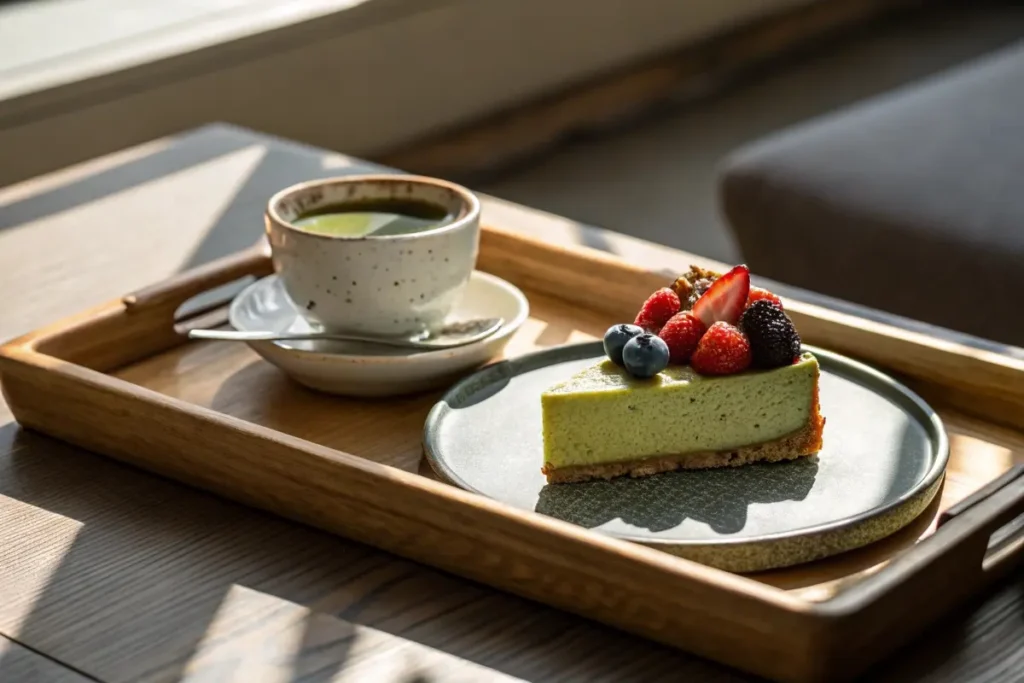Finding healthy japanese desserts can feel like discovering the ultimate sweet spot—literally and figuratively—where you enjoy delicious treats with minimal guilt. Japan’s dessert culture often leans toward balanced sweetness, smaller portion sizes, and high-quality, wholesome ingredients. From wagashi (traditional confections) to modern twists on Western pastries, many Japanese sweets offer a lighter approach compared to heavily sugared Western desserts. In this article, we’ll answer questions like What is a healthy Japanese dessert? and Are Japanese sweets healthier? We’ll also explore Japan’s most popular dessert, the healthiest dessert options, and how you can easily recreate them in your own kitchen.
For a broader glimpse into the diversity of Japanese desserts—both indulgent and health-conscious—visit our Japanese Dessert Recipes section, which showcases everything from simple fruit-based treats to more complex wagashi. Ready to dive into a world where sweet satisfaction meets a mindful approach to sugar and ingredients? Let’s begin.
Introduction
In today’s health-conscious era, dessert lovers often seek ways to satisfy cravings without overloading on empty calories or artificial additives. Healthy japanese desserts address this dilemma by utilizing nutrient-dense components—like azuki beans, matcha, fruits, and rice flours—and by maintaining moderate sugar levels. Many Japanese sweets highlight natural flavors, pairing well with tea or minimal sweeteners so that the inherent taste of ingredients truly shines through.
Japan’s dessert culture encompasses more than just mochi or fruit-based jellies. You’ll also encounter tofu puddings, sweet potato pastries, and even reinterpretations of Western cakes with a distinctly lighter, more refined finish. Whether you’re looking to watch your sugar intake, cut down on processed foods, or simply explore unique flavor profiles, these desserts offer both novelty and nutritional value.
Throughout this article, we’ll unpack Are Japanese sweets healthier? and delve into the country’s emphasis on fresh produce, balanced portions, and minimal additives. You’ll also discover tips for making your own healthier desserts at home—perhaps using matcha, sweet potatoes, or beans. And if you’re keen on more savory or balanced meal inspirations, check out our Japanese Chicken Fried Rice Recipe as the perfect main dish before a light dessert. Let’s explore the delightful intersection of taste, tradition, and well-being in Japanese sweets.
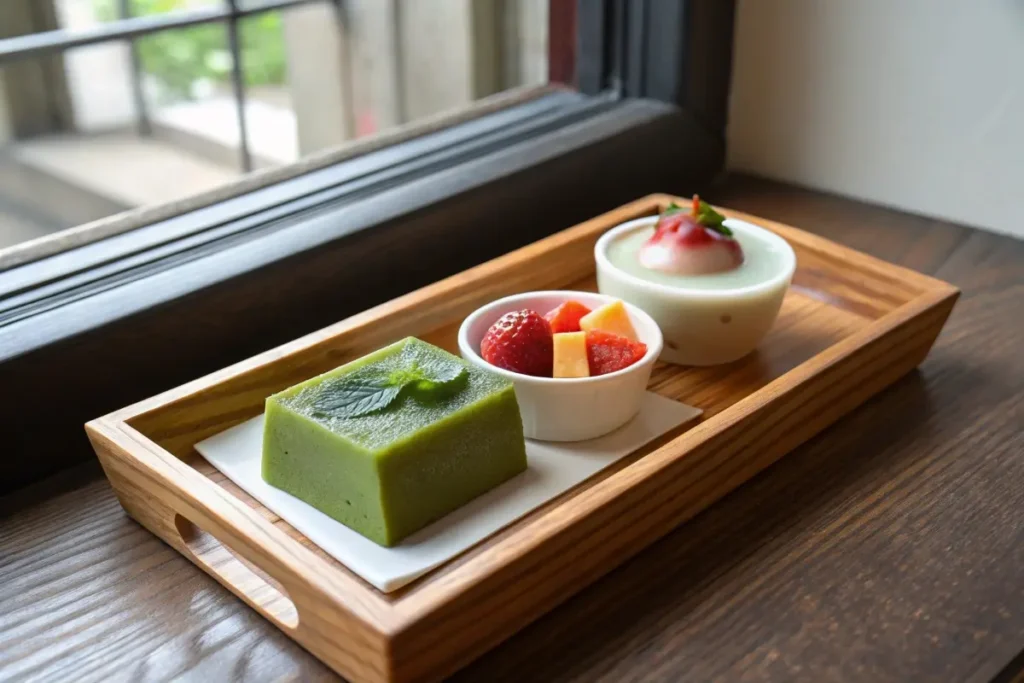
The Core Principles of Healthy Japanese Desserts
1. Emphasis on Subtle Sweetness
One of the defining traits of healthy japanese desserts is moderation in sugar. Compared to many Western pastries, these sweets rely on natural sugars—from fruit, beans, or sweet potatoes—combined with minimal refined sugar. This approach results in:
- Milder Taste: The flavors remain delicate, enabling you to appreciate matcha’s bitterness or sweet potato’s earthy sweetness.
- Reduced Calories: Fewer empty calories means you can indulge without significant guilt.
2. Wholesome Ingredients
Azuki Beans (Anko): Often forming the base for mochi fillings or paste-based confections, anko is high in protein and fiber while providing sweetness from natural or lightly processed sugars.
Mochi (Glutinous Rice): Made from pounding cooked glutinous rice, mochi offers a satisfying chew with minimal added fat. The carbohydrate profile might be high, but it’s easy to portion and combine with fiber-rich fillings like sweet bean paste or fruit.
Matcha (Green Tea Powder): Rich in antioxidants, matcha is frequently used in cakes, puddings, or jellies. Its slightly bitter note can help reduce the need for excessive sweeteners.
Sweet Potato and Kabocha (Japanese Pumpkin): These starchy veggies transform into sweet, hearty dessert bases, requiring little extra sugar. For instance, our Mashed Japanese Sweet Potato Recipe can be repurposed into dessert pies or small sweet potato cakes.
3. Balanced Portions and Presentations
Japanese food aesthetics stress harmony—between taste, color, and plate arrangement. Rather than indulging in large slices of cake, diners typically enjoy smaller, visually appealing servings that satiate without overconsumption. This approach naturally aligns with healthier dessert philosophies worldwide.
4. Minimal Processing
Many traditional sweets rely on basic techniques: steaming, boiling, or minimal baking. Wagashi like mizu yokan (bean jelly) or shiratama dango (rice dumplings) are gently cooked to retain natural nutrients. They also often forgo heavy creams or artificial flavorings, cutting down on saturated fats and chemicals.
5. Local, Seasonal Produce
Using in-season fruit (strawberries in spring, peaches in summer, persimmons in fall, etc.) is common. This ensures vibrant, fresh flavors with fewer preservatives or sweeteners. Even modern Japanese dessert chefs adopt seasonal menus for parfaits and pastries.
6. Mindful Pairings
To enjoy a dessert in a truly healthy sense, Japanese culture suggests pairing them with unsweetened tea—like green tea or hojicha. This synergy helps cleanse the palate and maintain a moderate sugar intake. The hot beverage can also aid digestion.
For more insights into how vegetables integrate seamlessly into sweet recipes, see our Vegetables Japanese Recipe section. You’ll realize many items there can double as core dessert ingredients—like kabocha or sweet potato—highlighting how flexible Japanese cooking can be. Ultimately, the foundation of healthy japanese desserts rests on minimal sugar, nutrient-dense bases, portion control, and a thoughtful approach to flavors—resulting in treats that are as kind to your waistline as they are pleasing to the palate.
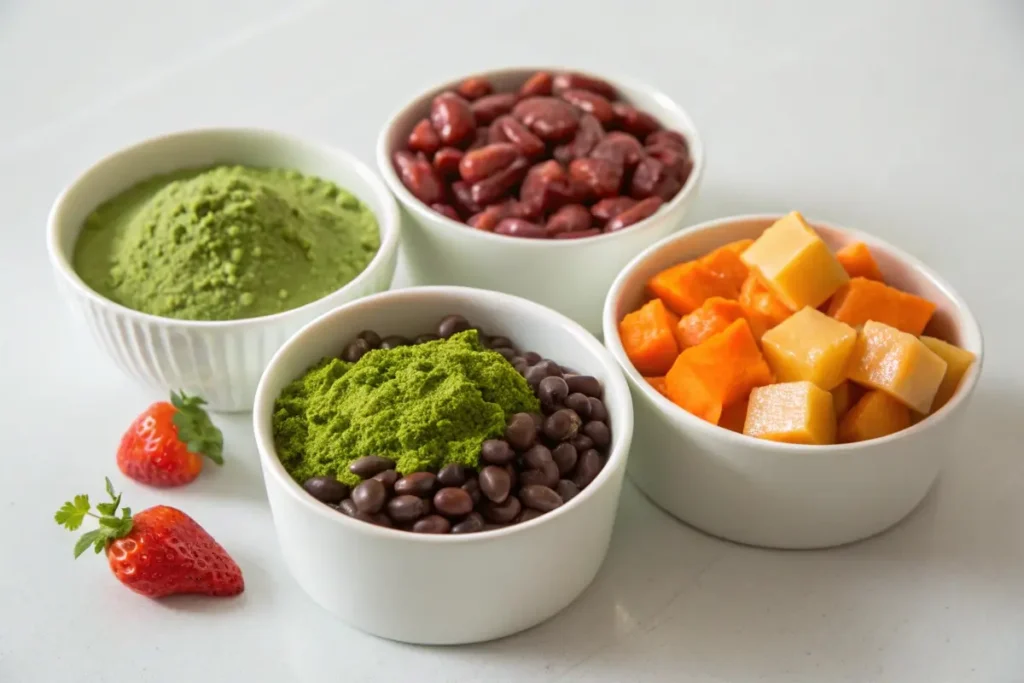
Top Healthy Japanese Dessert Picks
1. Anko-Based Treats
Daifuku: A staple in the world of healthy japanese desserts, daifuku is mochi stuffed with lightly sweetened anko. Thanks to mochi’s high satiety factor and anko’s nutritional profile (protein, fiber), this sweet can be quite filling without requiring a large portion. Some daifuku also contain fresh fruit—like strawberries—to add natural sweetness and vitamins.
Dorayaki: While typically known for thicker pancake layers, a lightly sweetened version can reduce the sugar content significantly. Switch out refined flour with partial whole wheat or other healthier flours to amp up the fiber.
2. Matcha Desserts
Matcha Pudding or Purin: A soothing alternative to chocolate pudding. By pairing matcha’s potent antioxidants with minimal sugar and a low-fat dairy (or soy milk), you can achieve a creamy but balanced dessert. Topping with azuki paste or fresh fruit adds a dash of sweetness and nutrients.
Matcha Chia Pudding (Modern Fusion): Not a traditional item but a quick, healthy approach. The chia seeds gel with matcha and milk (or a dairy-free alternative), forming a lightly sweet dessert reminiscent of modern superfood bowls. Add a drizzle of honey and fruit for garnish.
3. Fruit-Focused Sweets
Mikan Jelly: Mikan is a mandarin orange variety popular in Japan. A homemade gelatin or agar-based jelly harnesses the fruit’s natural sugars, requiring just minimal added sweetener. The result is a refreshing, vitamin-rich dessert.
Ume or Yuzu Sorbet: For something tangy, combining pureed yuzu or pickled plum (ume) syrup with water (and minimal sugar) can produce a palate-cleansing sorbet. This dessert exemplifies how Japanese flavors lean toward refreshment rather than overwhelming sweetness.
4. Sweet Potato & Kabocha Confections
Sweet Potato “Yokan”: A twist on the classic bean jelly. Substituting sweet potato puree reduces the sugar load while delivering vitamins and fiber. The dessert’s bright golden or purple color (depending on the variety) also makes for an eye-catching treat.
Kabocha Cheesecake: Rather than a heavy Western cheesecake, Japanese styles often use lighter cream cheese ratios, sometimes blending in mashed kabocha squash for a velvety consistency. This approach can cut back on sugar while adding nutrients from the squash.
5. Tofu and Soy Options
Tofu Pudding (Tofu Purin): Blended silken tofu sets with a bit of agar or gelatin, sweetened gently with honey or fruit syrup. The result? A no-bake pudding that’s high in protein, low in refined sugar, and easily adjustable in flavor.
Kinako (Soybean Flour) Toppings: Sprinkling toasted soybean flour on mochi or fruit bowls offers a nutty taste and a slight protein boost. Combining kinako with a dash of sweetener (like sugar or stevia) can replace heavy cream-based sauces.
For a variety of practical recipe inspirations, see our Japanese Sweet Potato Air Fryer Recipe for a snack that can easily adapt into dessert territory by adding a cinnamon-honey drizzle. The synergy of sweet potatoes and minimal processing underscores the essence of healthy japanese desserts—focusing on naturally nutrient-rich foods and balanced flavors.
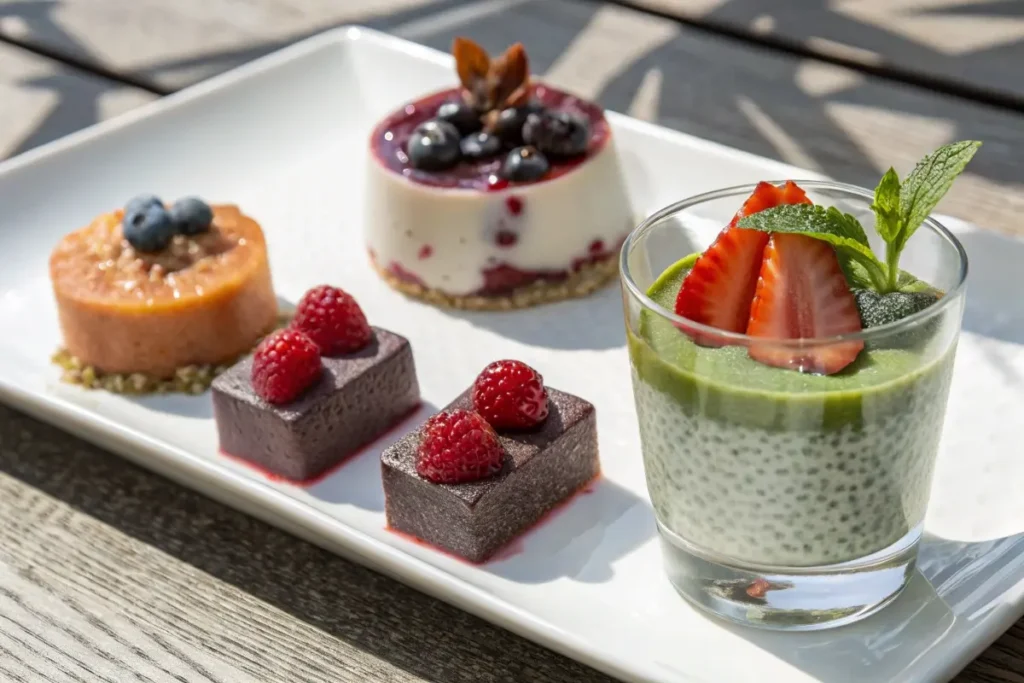
History and Examples: Healthy Japanese Desserts
1. Roots in Wagashi
Traditional wagashi emerged centuries ago when sugar was a precious commodity, leading artisans to rely on minimal sweetening. This naturally fosters a healthy japanese desserts legacy, as confections were never intended to be overly rich or large in portion. Instead, the hallmark was subtlety—echoing the cultural ideal of harmony (wa) in taste and aesthetics.
Chanoyu Influence: During tea ceremonies, small sweets mitigate tea’s bitterness. Because matcha or green tea has potential health benefits (like antioxidants), offering a sweet with moderate sugar ensured the treat complemented, rather than overshadowed, the tea experience. Over time, this practice cemented the notion that Japanese desserts should be balanced—quietly sweet, never cloying.
2. Post-War Shifts and Health Awareness
As Japan’s economy evolved post-WWII, Western pastries and convenience foods surged, including sugar-laden items. But concurrently, a portion of society maintained the wagashi tradition or adapted Western sweets with Japanese elements—like less sugar or the inclusion of matcha or azuki paste. This evolution shaped modern “lighter” cheesecakes or airy chiffon cakes.
Health Movements: By the late 20th century, as global concerns about obesity and lifestyle diseases grew, the demand for low-sugar or fruit-based desserts rose in Japan, spurring new product lines in supermarkets. Tofu-based sweets or sugar-reduced mochi desserts gained traction, bridging old methods with new research on balanced diets.
3. Contemporary Healthy Innovations
Current dessert innovators still honor the core principle of low sugar and natural flavors but incorporate global superfoods or culinary techniques. Examples:
- Mochi Doughnuts: Some are baked, not fried, or use less sugar.
- Vegan Wagashi: Substituting dairy or eggs with plant-based alternatives.
- Sugar-Free Options: Using zero-calorie sweeteners or natural fruit sugar, especially for diabetics or low-carb diets.
4. Cultural Significance
While elaborate Western pastries exist in Japan, many people still prefer simpler, healthy sweet options for day-to-day consumption. A typical scenario: enjoying a single piece of anko-filled mochi with unsweetened green tea as a midday pick-me-up. This underscores how healthy Japanese dessert culture merges taste, tradition, and mindful consumption.
To see how vegetables or plant-based items can star in your dessert repertoire, check out our Japanese Vegan Recipes for additional ideas. You’ll notice how an emphasis on fresh produce or minimal processing is embedded not only in main dishes but in desserts as well. In essence, the historical lineage and continued evolution of healthy japanese desserts stand as a testament to Japan’s culinary adaptability and its abiding focus on well-being.
Practical Examples/Use Cases
1. Quick and Easy Fruit Parfait
Scenario: You want a fast dessert after dinner.
- Approach: Layer fresh fruits—like diced persimmon, strawberries, or peach slices—with low-fat yogurt or soy yogurt. Sprinkle matcha powder or toasted sesame seeds on top for a subtle Japanese flair.
- Outcome: You get a parfait that’s low in added sugar but high in vitamins and flavor—perfectly aligned with healthy japanese desserts ideals.
2. Healthy Bento Dessert Pack
Scenario: Preparing a balanced lunch box for work or school.
- Approach: Include a small container with chilled matcha jelly or a single daifuku mochi. This portion size ensures a sweet treat that won’t spike blood sugar too drastically or weigh you down.
- Benefit: Simple, portion-controlled indulgence, consistent with the Japanese concept of not overdoing sweets.
3. Matcha Tofu Ice Cream
Scenario: Craving ice cream but mindful of sugar and fats.
- Approach: Blend silken tofu, matcha powder, a minimal sweetener (like honey or stevia), and freeze. Periodically stir to reduce ice crystals.
- Result: A homemade “ice cream” that’s creamy yet lower in saturated fats and refined sugar—still capturing that distinctive green tea essence.
4. Community Workshops
Scenario: A local health fair invites participants to learn about healthy dessert alternatives.
- Approach: Demonstrate how to make anko with half the usual sugar or a sweet potato-based dessert. Encourage portion control and pairing sweets with unsweetened tea.
- Value: Hands-on experience fosters understanding of how easily sugar intake can be curbed without compromising taste.
If you’re keen on exploring more sweet potato-based concepts—since sweet potatoes feature strongly in “healthier sweets”—see our Japanese Sweet Potato Air Fryer Recipe for a convenient, near-guilt-free snack or dessert. By focusing on natural sweetness, fiber, and minimal extra sugar or fat, it epitomizes the straightforward approach many healthy japanese desserts follow: real ingredients, balanced portion, and flavor synergy over sugar overload.
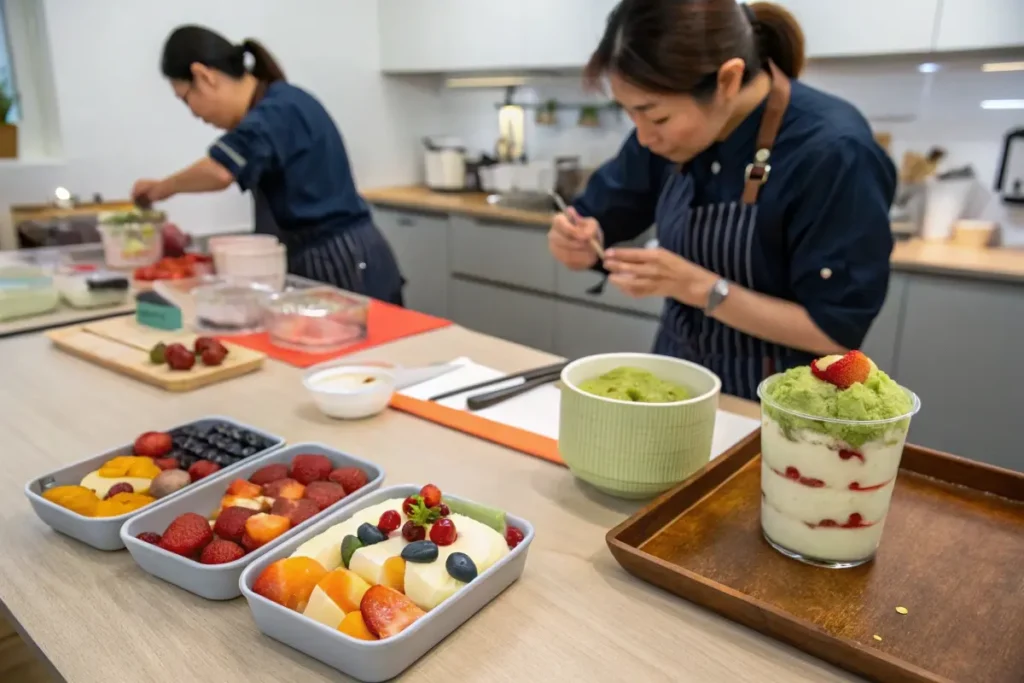
FAQs
1. What is a healthy Japanese dessert?
A healthy japanese dessert often utilizes natural sweeteners (like fruits or minimal sugar), plus nutrient-rich ingredients like azuki beans, sweet potatoes, or matcha. This modest sugar approach and smaller portion sizes help control calorie intake.
2. Are Japanese sweets healthier?
In many cases, yes. Japanese desserts typically prioritize balanced sweetness, incorporate fiber-rich components (beans, root vegetables), and come in single-serving or bite-size forms. However, some modern pastries can still be high in sugar or cream. Always check ingredients or portion carefully.
3. What is Japan’s most popular dessert?
Popularity can vary by region and trend. Classic mochi is ubiquitous, while purin (custard pudding) and dorayaki remain staples. In modern cities, fluffy soufflé pancakes or matcha parfaits are trending. For healthier spins, fruit jellies or lightly sweetened mochi are common picks.
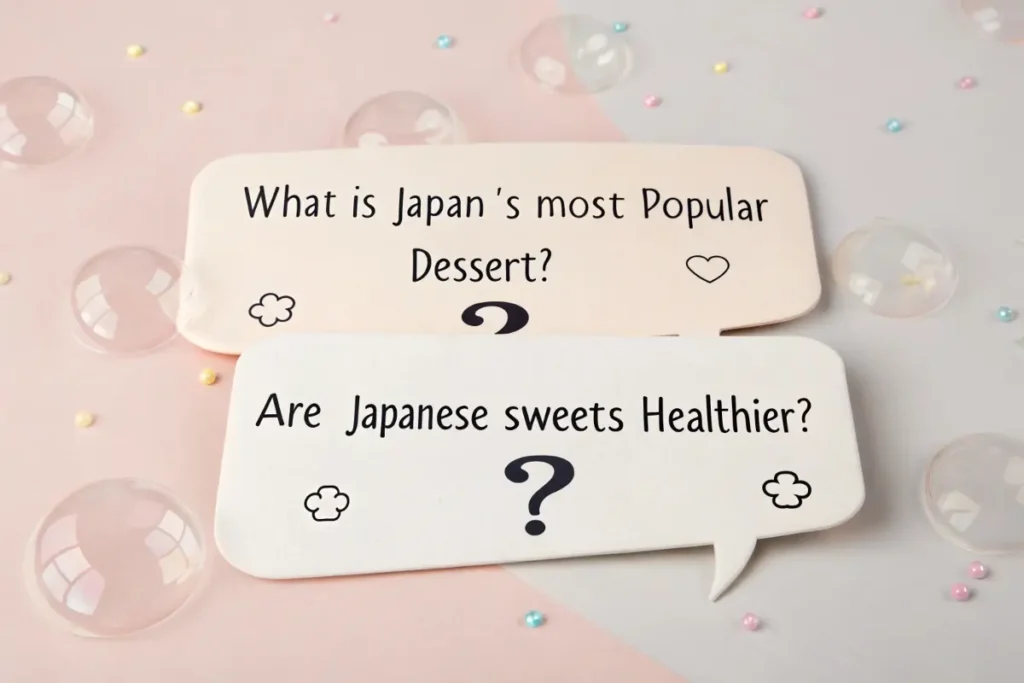
4. What is the healthiest dessert?
No single dessert stands out as “the healthiest,” but items like fruit-based jellies, tofu puddings, or minimal-sugar mochi can be quite beneficial. They typically feature fewer refined carbs and lower sugar, harnessing naturally sweet or high-protein ingredients. Pairing these with unsweetened tea ensures an even gentler glycemic impact.
5. Do these desserts suit special diets?
Yes. Plant-based or vegan dieters can enjoy many wagashi—mochi, anko—since they often exclude dairy or eggs. Gluten-free eaters benefit from rice flour–based confections. Even low-sugar variations exist with sweet potatoes or zero-calorie sweeteners. Double-check recipes or vendor statements to confirm specific dietary needs.
6. How can I replicate them at home?
Simple mochi or anko-based sweets are accessible. For advanced attempts—like matcha chiffon cake or intricate nerikiri—additional practice helps. Our Japanese Vegan Recipes section shares simpler, plant-forward dessert ideas. Start small, refine techniques, and experiment with flavors that inspire you.
7. Where can I find these ingredients?
Asian supermarkets, specialty Japanese grocers, or online stores typically stock glutinous rice flour, matcha powder, anko, and Japanese sweet potatoes. Farmers’ markets also supply fresh produce like kabocha or persimmons, vital for seasonal fruit-based sweets.
Conclusion
Healthy japanese desserts embody more than just low sugar and fresh ingredients. They reflect a cultural ethos emphasizing balance, artistic simplicity, and a mindful approach to eating. From bean-based sweets like mochi or daifuku to fruit-laden jellies and matcha-infused puddings, Japan’s sweet repertoire showcases how desserts can nourish both body and spirit—without drowning in sugar or additives.
If you’re eager to incorporate these treats into your routine, begin by experimenting with fundamental recipes: homemade anko, sweet potato purees, or tofu-based puddings. Gradually expand to more complex items, like a reduced-sugar matcha roll cake or kabocha cheesecake. Meanwhile, using unsweetened tea, fruit syrups, or modest honey drizzles can help further reduce empty calories.
Looking for a complete healthy meal plan that complements lighter desserts? Head over to our Healthy Japanese Recipes for savory dishes that pair beautifully with your chosen sweet finale. In essence, each bite of a well-crafted, health-oriented Japanese dessert testifies that indulgence and wellness can coexist harmoniously, celebrating natural flavors and mindful consumption. Embrace the joy of gently sweet, nutrient-packed treats, and discover the best of Japan’s dessert culture—where tradition and innovation converge for a more wholesome delight.
